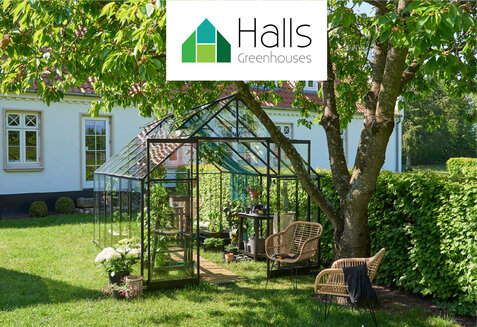Vertical Gardening: Stand on your Head and Grow Verticallly
With vertical gardening, you can grow a variety of plants in very little space. Vertical gardening is perfect for those with a smaller greenhouse, balcony, or garden.

In Holland it is possible to find high-rise blocks made almost entirely out of glass. You would immediately assume it would be for an office building or for a residence, however, they are for habitation. Not for humans, but for tomatoes.
Holland holds the world record for growing the most kilos of tomatoes on just a single square metre. The record is 90 kilos. Because we are on our way of becoming 11 billion people on this earth, there is less and less room for all of us, and because of the CO2 emission and transport, there is a need to utilize space in new ways. One of the ways leads us straight towards the sky and is known as vertical gardening or farming.
In your greenhouse (or garden, balcony, or terrace), it is possible to grow vertically and to maximise the potential of the space you have, to make room for both you, and your plants. Greenhouses have become very popular and have almost completely replaced the winter gardens of the 70’s and 80’s. We long for greener environments in general and want therefore also more space in our greenhouses. Plants and people do really well together. We take advantage of each other and get energy from each other.
On One Side or the Other
Vertical cultivation is basically a combination of both vertical and horizontal cultivation. A cucumber is for example, by nature, a climber, that climbs its way up over the treetops in the jungle. It only grows vertical. Tomatoes grow in the same way. They grow from the ground up and the higher they grow, the more tomatoes they produce. The same applies to French beans and tall peas. Therefore, it makes little sense to grow for example tomatoes vertically, unless you want them hanging down from the ceiling, to become an eatable decoration, or if you need the room on the ground for something else.
Getting Started
There are different methods/materials you can choose from. Basically, there is no difference if you grow plants in pots that are hanging somewhere or standing on the ground. Either way, the material to grow in, must be drained and the plants must have water and fertilizer. Therefore, the questions you should ask yourself are how you will reach the proper height, how you will ensure water and fertilizer, and which containers you will grow in.

A ladder can be a decorative way to elevate your garden and save floor space. Photo: Grøn Kommunikation ©

A hanging basket with a mat of coconut fibre. Photo: Grøn Kommunikation ©
Hanging Baskets
Hanging baskets are a great option to get your plants off the ground. There are a lot of different kinds and materials to choose from. However, there are open wire baskets that you can hang on a hook, and which are lined with a mat made of coconut fibres, that is shaped like a pot. The mat comes with the purchase or is already built in the basket. By using a coconut mat instead of a closed clay or plastic pot, you can make an incision with a scissor or sharp knife into the sides, so it is possible to plant in the sides and not only in the middle of the pot. The coconut mat can also lead away excess water. To collect some of the water, you can place a piece of plastic or a saucer in the bottom. The hanging baskets are especially suited for growing flowers or strawberries, which completely hide the pot. It is important, when planting in the sides of the coconut mat, that the plants are small. A bigger root net can more easily be damaged.
Recycle
Pots can be anything, as long as they can contain water. That means clay, ceramics, fabric, bags, cut open soda bottles, jute sacks and so on can be used. For a vertical garden, preferably choose materials that are not too heavy. Light materials are easier to set up and you also don’t have to carry heavy pots up the stairs, if you, for an example, are making a vertical structure on a third-floor balcony.
Shelves
A vertical gardening structure can also consist of a couple of shelves build on top of each other. In Juliana’s assortment, you can always find shelves to put up in your greenhouse. If you are looking for a different style, use recycled shelves or build your own with bricks and wooden boards.

t is an advantage to grow your plants in light pots and containers. Here old plastic containers are used. The plants grow in clay pebbles and are supplied with water from an irrigation system. Photo: Grøn Kommunikation ©

A trellis is a great way to divide your greenhouse in different areas and to hang up plants. Photo: Grøn Kommunikation ©
Pots in a Tower
- Buckets for paint are a good idea as well as they can be put on top of each other. Drill some holes, for the plants, in the side of the buckets and all the way around. Maybe line them with jute and cut a hole in it afterwards.
- Fill the buckets with soil all the way to the edge and place as high up as you want.
- A big plastic pipe with a rather large diameter can be used in the same way.
- If you are being really creative, place beautiful cans on a string next to each other.
- A ladder is very suited as a shelf. Furthermore, it is possible to buy already made wall systems.
Potts on the Wall
In a more creative way, you can make a dividing wall in your greenhouse out of a trellis, where you can hang pots or flower boxes, for example made of felt or plastic.
Out by the terrace or in the garden, you can build a wall of pallets or boards and hang different pots in a row.
With plastic or fabric and staples, you can also easily build shelves for your plants into your pallets.

Her kan man virkelig tale om en vertikal have, hvor alle højder er udnyttet optimalt. Foto: Grøn Kommunikation ©
Plant Examples
Tomatoes are well suited for hanging baskets. Choose a medium-sized variety, for example the ones we call cherry tomatoes. A possible sort could be ‘Macot’, ‘Venus’ or the bigger ‘Tiny Tim’. Plant your tomato in the middle of the pot and press down soil around it. There should be a few centimetres up to the edge, so the water won’t overflow when you water your plants.
Strawberries
Strawberries are also suited for vertical cultivation in hanging baskets and on shelves, especially smaller sorts like ‘Fragaria vesca’. In general, plants with small root nets are best suited for growing in hanging baskets. This includes almost all spices, but also peas and chillies.
No matter what you plant, the most important thing is the soil, drainage, watering, and fertilizer. If you don’t manage these things, your project will fail.

Tomatoes can easily reach a decent height, if the house is big enough. Photo: Grøn Kommunikation ©

Hanging tomatoes with a homemade irrigation system. Photo: Grøn Kommunikation ©
Soil
Generally, all plants will grow in potting soil. If you are able to get soil with coconut coir, that is the best. In small containers, like pots, it is important to have a good drainage system. In the hanging baskets with coconut fibres, there is a build-in drain, but in more closed containers it is important to mix the soil with clay pebbles to improve drainage.
Fertilizer
Use a long-life fertilizer and water with a liquid fertilizer. In the first 14 days, the plants don’t need fertilizer.
Water
Watering is the biggest challenge, when talking about vertical cultivation. Everything that is not directly grown in beds should be watered regularly. The smaller the pot, the more often the plant needs water. It is a big advantage if you have a rainwater barrel right by the greenhouse. This way, you always have tempered water. Some bought vertical gardening systems include a drip irrigation system. Buying a separate drip irrigation system is otherwise also an option. Gardena has a good selection, and some options where the pump is powered with batteries charged by the sun.

A sun powered pump, like this from Gardena, is a great option to automatise the irrigation with the water from a rain barrel. Photo: Grøn Kommunikation ©

This drip irrigation makes sure the pots get water. Photo: Grøn Kommunikation ©
The Advantages of Vertical Gardening
There really is no difference in growing in pots standing on the ground or growing vertically. The advantages of growing vertically in a greenhouse, is of course more floor space for beds, larger pots, or furniture. Some pests’ need contact with the soil to reach the plants.
Furthermore, you get the opportunity to grow something, you would not have grown in your garden, like early strawberries. You can also create a jungle like atmosphere and turn the greenhouse in your very own paradise.

A way to grow vertical is to arrange your plants on different levels, like on a staircase. Photo: Grøn Kommunikation ©

It is possible to buy ready-to-use vertical containers with an irrigation system. Photo: Microgardens.dk
The drawback of vertical gardening is frequent watering, thus taking up more of your time.
However, if you like watering, this is not a problem.You might reduce the need for watering by choosing self-watering pots, drip irrigation systems or hydroponic cultivation methods.
There are also ready-to-use wall systems with build in drip irrigation systems.

JULIANA GROUP
Juliana Group er en førende global leverandør af kvalitetsdrivhuse til private. Virksomheden blev grundlagt i 1963 af Mogens A. Stærmose i Odense, Danmark. Den familieejede virksomhed ejes i dag af 3. generation, Nikolaj Stærmose. Hovedkontoret og fremstillingen er stadig beliggende i Odense med datterselskaber i Storbritannien og Tyskland. Juliana Group eksporterer til mere end 20 lande.
’We help people grow’. Derfor sætter vores brands Halls, Juliana og Gabriel Ash rammen for oplevelser, der er lige så naturlige, som de er magiske. Til trods for vores lange historie er vi fremadskuende og nysgerrige på, hvordan vi kan forbedre bæredygtigheden af vores drivhuse. Få mere at vide om Juliana her på siden og bliv en del af vores online fællesskab for alle drivhusentusiaster på Drivhusklubben.dk







